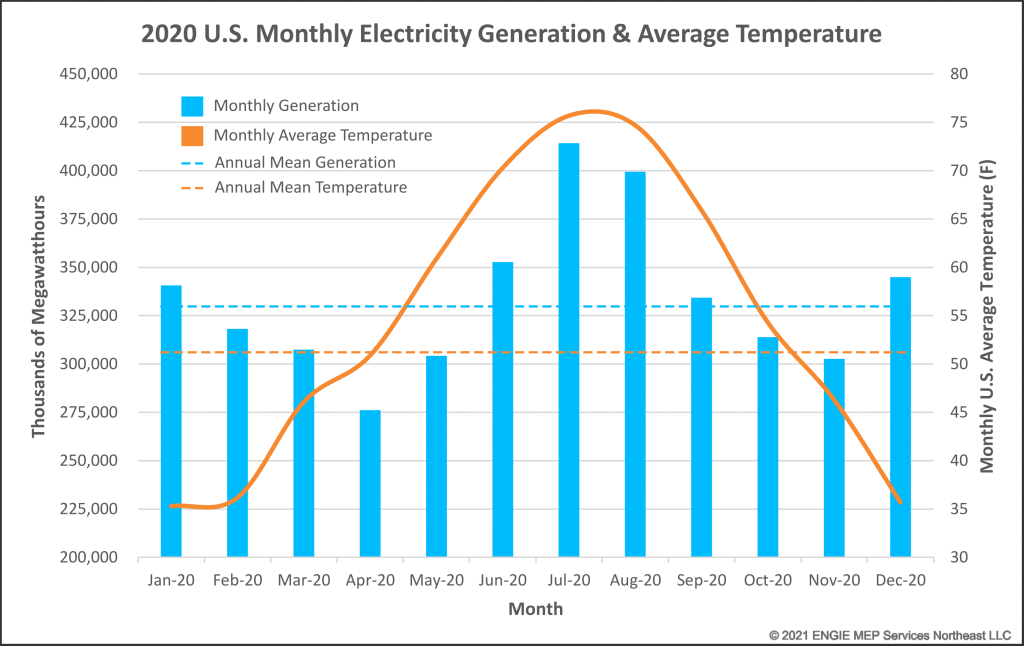Corporate Peak Shaving
Posted on July 13th, 2021Among all the corporate responsibility issues property owners and business leaders should consider, peak shaving should be towards the top of the list. This may seem odd, but the reasons and the solutions are good for all: the corporate bottom line, the environment and the community.
Peak Electricity Demand
It is well known that the daily demand for electricity tends to be highest in the afternoon and lowest at night. It is also well known that the demand for electricity in the U.S. is highest on hot, humid summer days. This peak in electricity demand has a variety of undesirable ramifications.
The graph shows the average monthly demand for electricity and temperatures for 2020. Of critical note is how the demand for electricity peaks in July more than 27% higher than the annual mean demand. To satisfy that July peak, electric utilities needed to have additional generating capacity that operated only a few hundred hours and was not needed for the rest of the year. The option, of course, is for utilities to buy electricity from one another, however widespread summer heatwaves often leave little or no extra electricity available for sale.
Beyond the peak demand, utilities are often required to have a reserve generating capacity of up to 25% in case the forecast is incorrect or some facilities are out of service. To make things more difficult, the seldom-used facilities often have the poorest energy efficiency and produce relatively higher amounts of greenhouse gases. All of this adds to the cost of electricity and the cost to reduce CO2 emissions.
Peak Shaving

There is only one way to reduce the downsides of an extraordinarily high peak demand: reduce the peak or “shave” it. In the challenge to shave the peak demand there are multiple opportunities. Peak shaving is simply a reduction in the demand for electricity when it is at its highest, usually between 1 p.m. and 6 p.m. daily on hot, humid summer days. For businesses and property owners, there are numerous means for peak shaving.
There are some simple ways to reduce summertime electricity usage. Use natural sunlight to reduce lighting loads. Shift working hours so employees can finish work earlier or start later to reduce air conditioning loads during the hottest part of the day. Employees working remotely on the hottest days would also help reduce the peak demand.
Another way to reduce peak demand is called “load shifting”. This means delaying processes that require larger electrical loads until “off-peak” hours, where possible. Avoid the use of conference rooms, auditoriums, commercial printing equipment, etc. during peak demand time to reduce electricity use.
Finally, participation in what is broadly called a “demand response” program, often provides an income stream for property and business owners willing to reduce their energy consumption for a couple of hours when requested by the local utility. A typical demand response or DR program pays customers for what amounts to negative electrical demand. When the daily peak electrical demand will be extraordinarily high, the utility simply requests DR program participants to temporarily reduce their electrical usage to help reduce the peak.
The utility pays DR program participants out of the savings realized by minimizing the operation and maintenance of older, inefficient and less environmentally friendly generating plants. A Massachusetts study demonstrated the magnitude of this saving when it reported that the most expensive 1% of hours generated accounted for 8% of consumers’ electricity costs while the top 10% of hours accounted for 40% of annual electricity costs.
Many businesses and property owners have sustainability goals, but those goals typically focus on future zero-carbon energy resources and not on the necessities of a reliable electricity supply for today. Renewable resources such as wind, solar PV generation and battery energy storage, however, cannot yet be counted upon to satisfy high summertime peak demands. For the foreseeable future, the highest annual electrical demands will confidently be met only using fossil-fueled generation. This is a further reason peak shaving should be part of a corporate sustainability plan.
For most commercial and institutional properties, air conditioning represents the largest summertime electrical load and also one of the largest opportunities for demand reduction. The engineering and service professionals at MEP Services are HVAC, building automation and energy efficiency experts. Call on us to help you automate participation in a DR program or to simply assess your facility for energy efficiency and options for meeting your sustainability goals.
